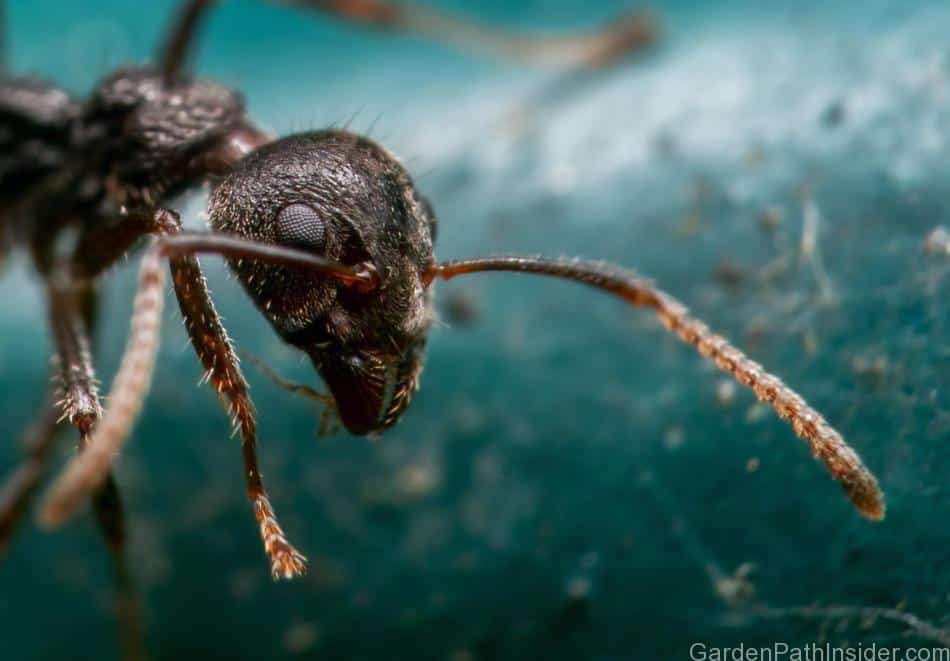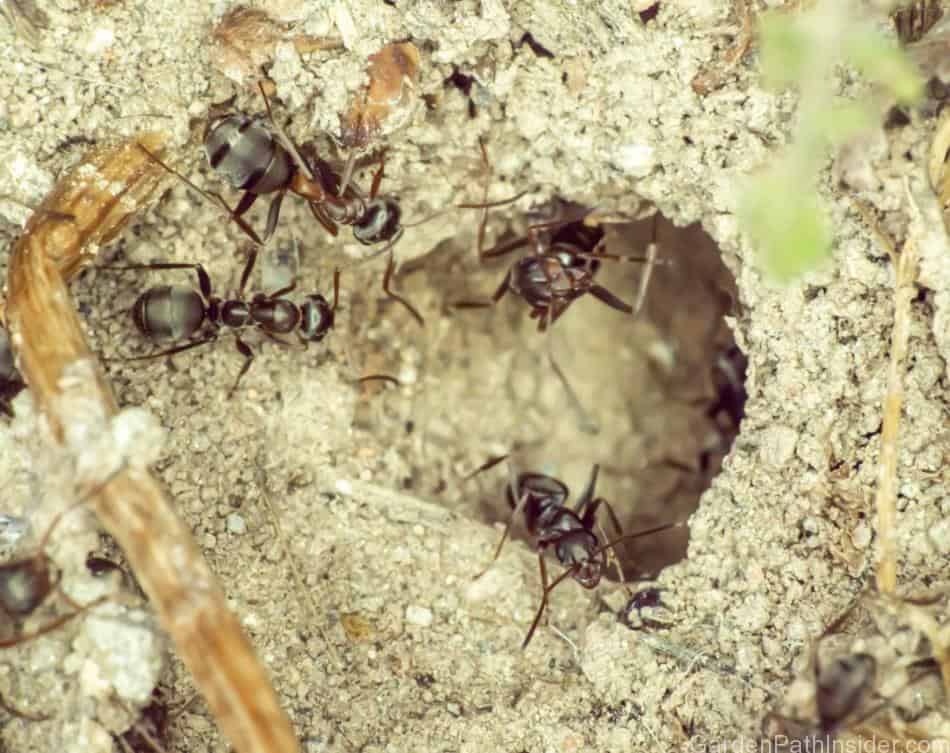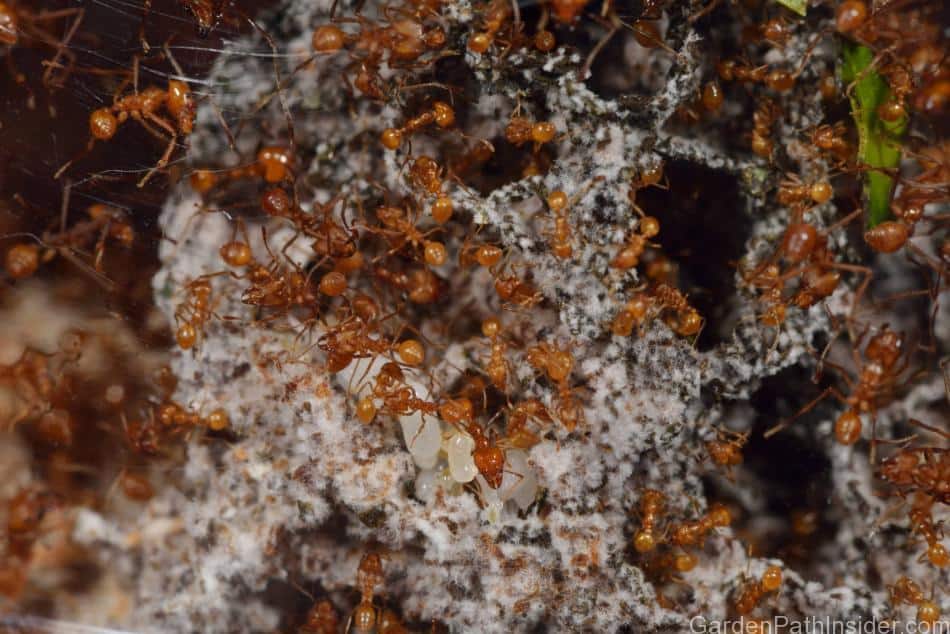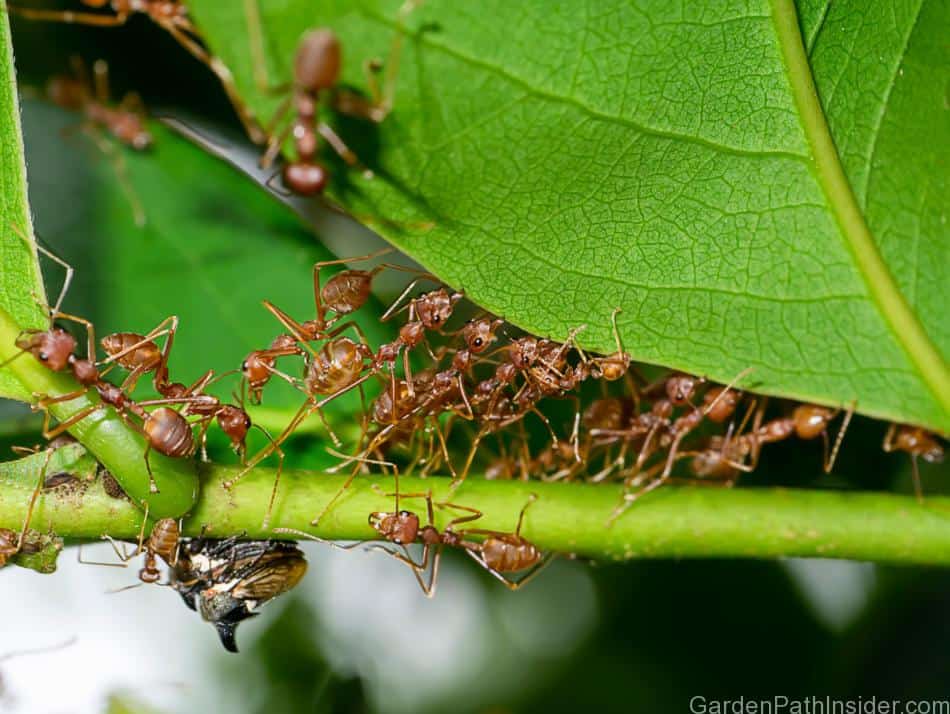
Ants are found on almost every continent and ecosystem. The annual life cycle of ants can vary by where they live and their species. However, all ant species need a rest period during unfavorable environmental conditions.
Ants hibernate during extreme cold weather. As ants are invertebrates, the correct term for this hibernation is Diapause. Diapause happens in the colder months of the year, regardless of the ants’ home climate. The diapause rest allows the queen, after waking, to produce larger healthier broods.
The exact length of the diapause depends on the ant species and the climate of their habitat. The colder and more harsh the climate, the more impressive an ants’ preparations must be to sustain the rest period.
Spending the cold months in a state of diapause is one piece of the strategy ants use to survive winter. While an adult ant may be able to rest during diapause, other actions of the nest must continue during the cold months.
To develop a successful colony, ants have to protect every aspect of their nest during the cold months. Ants accomplish this by building large nests up to 0.002 m3 in volume and extending to depths of 7 meters. These nests can contain many caverns that are used for fungus gardens, food storage, larva nurseries, garbage holding areas, and even morgues. Source: www.fs.usda.gov
Going into cold weather, ants will insure their larva and their queen are protected from the coming cold spell.
The most important aspect of an ant colony is the queen ant, and protecting the queen at all costs.
Queen ants can live over 20 years in some ant species, and the worker ants can live up to 3 years. This long life span can keep a colony going for many generations. One reason for this long life is the structure of an ant nest, and the ant colony’s ability to adhere to the temporal caste system.
The temporal caste system means ants stay in one role of the colony during a specific age in their life. The young ants may tend to the larva, while the older ants closer to death may take on the more dangerous jobs of protecting the nest and foraging for food.
Many people raise ants indoors as pets. In the formicarium (ant farms) you can see this caste system and ant hibernation play out in real-time.
To learn more about ant farms read our article below where we address the ethical concerns about keeping ants as pets.
Click the link to read our article on keeping ants as pets, as we answer the question: Are Ant Farms Cruel?
There is one species of ant called the Prenolepis impairs ant, or winter ant, that hibernates during the summer and is active during the winter. Hibernation (diapause for ants) refers to animals that lay in a dormant state during the winter months, as this ant is dormant in the summer months that is called aestivation. The aestivation cycle is dormant in the summer and active during the winter. This is where the Winter ant gets its name. Source: www.nps.gov
Cover image: Macro Photography of Head of Tiny Black Garden Ant on Turquoise Floor_© backiris/123rf.com

How Long Do Ants Hibernate?
Ants stay in a dormant state during the colder months of their climates season. The length of the dormant period depends on several factors.
The length of ants’ hibernation (diapause) can last up to several months depending on the environmental conditions. Ants begin diapause when temperatures are between 41°F to 60°F (5°C to 15°C). Ants in tropical climates may go dormant at relatively warmer temperatures than ants in cold climates.
When weather patterns change, ants are forced to adapt their diapause (hibernation) schedule.
Ants will stay dormant through the cold periods in their specific climate. Ants that live in warmer climates will go dormant in relatively warmer temperatures than ants living in colder climates like the Northern US or Canada. If the temperature warms, the ants may wake from their diapause causing temporary confusion in the nest.
When there is a warm spell in winter, ants may be tricked into waking from their diapause. Ants that have not stored enough food in their nest will venture out in search of a meal. This is when we start seeing ants in our house during the cold months.
If you are experiencing an infestation of ants, the first step is to contact a local pest control professional to discuss the options to exterminate the infestation.
A professional will be able to address the current infestation and then apply a barrier to prevent future infestations. There are also options you can buy at your local home store, though it may be beneficial to still consult with a professional before tackling the nest on your own.
What Happens to Ants in the Winter?
Winter is a difficult season for all creatures, especially the small insects without natural defenses to protect from the cold. Ants have an extremely intelligent and structured society that helps to overcome even the harshest winter conditions.
Ants go into diapause (hibernation) in the winter months. Nearly all ant species go into this rest period in the colder months of their year, even if they live in relatively warmer climates. The rest helps the ants conserve energy when food may be more difficult to find in their environment.
Ants go dormant through the winter to conserve resources and rest. However, the colony is able to survive the winter thanks to the structure and resources their intricately designed nests provide.
The metabolic process of ants going into diapause (hibernation) helps the ants as individuals survive the winter months. The real hero in the ant’s fight for winter survival is the ant nest itself.
The ant nests contain many chambers and tunnels that are used as ant larva nurseries, food storage of organic matter, garbage holding areas, morgues for dead ants, and even fungus gardens to feed the colony.
Ants are able to fit all of this in their nests by building large nests up to 0.002 m3 in volume and extending to depths of 7 meters. Source: www.fs.usda.gov
Ant colonies work together to build stores of food for the adult ants and the ant larva. Some species of ants actually farm fungus and insects as food sources for their colonies.
Ants often farm and herd aphids for the aphid’s sugary excrement called honeydew. Ants will bring adult aphids and aphid larva into the ant nest to spend the winter and herd the aphids back out of the nest in the summer.
To learn more about ants farming methods and the crops ants farm, read our article in the link below.
Click the link to learn about ants farming and cultivating crops and livestock in our article: Can Ants Farm?

What Do Ants Eat in the Winter?
Ants have learned to thrive in harsh conditions by building safe and secure nests and cultivating the land and available prey species as food sources for the colony. With these preparations, ants can survive in environments even during times of drought or icy weather.
Ants tend to lay dormant in their nests during the colder months and do not eat too often. If ants do wake during a warm spell they can eat from their nest’s fungus garden. Fungus gardens are kept by many ant species and help sustain the adults and larva alike.
Ants farming crops is an interesting aspect of their colony’s ability to thrive around the globe. The ants’ crops can range from plant-based fungus to aphids that are herded and milked like cows.
Many species of ants are accomplished farmers and can grow enough food to sustain colonies of more than a million ants strong.
We have covered ant farming in great detail in our article: Can Ants Farm?
In the article, we show beautiful pictures of ants’ fungus gardens, and ants herding and milking aphids. We discuss the methods of crop cultivation and the strategies the ants use to shepherd multi-generational aphid herds from one season to the next.
Click the link to read our article and see pictures of ants farming and crop cultivation in: Can Ants Farm?
What Do Ants Do in the Rain?
Ants have developed and passed down solutions to survive the most extreme weather conditions imaginable. When faced with rain and flooding ants have a solution for survival.
Ants stay in their nest during rain. Ant nests are designed with specially selected sand that whisks away water without eroding the entrance barrier. Additionally, the nest has many small compartments that trap air, should the nest flood. Though flooding is not common due to the design of the nest.
The materials and design of the ants nest are key to survival, but what happens during a rare nest flooding is even more interesting.
Ants build their nest in specially selected sands that allow water to drain away from the nest entrance quickly. While the majority of the nest is underground, its creative design and structure allow the ants to wait out the storm in a warm dry shelter.
The nest has a raised entrance to dam out water, and the inside is built with many compartments that safely house ant larva, and different food sources, along with rooms for garbage and even spaces for dead ants.
Some species of ants travel farther from the nest to forage for food. If it begins to rain while these ants are out on the trail, the ants will form a nest using leaves and the ants themselves. See the picture below

This strategy of temporary nest building is also used to protect the queen ant while the colony is on the move to find a new location to build a nest. The ants will march all day and then form a leaf nest for the night, to protect the queen and colony. Then in the morning the ants will detach from the nest and begin to march again.

During severe flooding, some ants even join together to form a floating raft. As shown in the image above.
Do Ants Hibernate in California?
Ants that live in warm climates also have to deal with the brief cold weather that may temporarily plague their otherwise temperate climate.
Ants in California hibernate if the temperature drops below 50°F (10°C). If the temperature drops below 60°F (15°C) the ants may go dormant temporarily without putting the whole nest in full hibernation mode. The hibernation (diapause) takes place in the coldest months of the year.
Most species of ants go dormant in the coldest periods of the year, even if is just during a snap cold spell.
California is warm almost all year round. However, there are still cold spells through the state that may trigger ants to go into a light dormant period. The dormant state usually only lasts as long as the cold spell, and life returns to normal quickly after it warms up.
Ant species in harsher climates in the northern states go into full hibernation (diapause) by thoroughly preparing their nest for extended rest.
Next Read!
If you enjoyed this article we recommend one of our most popular articles on Honey Bees: 50 Best Plants That Attract and Support Honey Bees!
In this article, we provide striking images of flowers and plants that will add color to your yard and support the Honey Bee. If you’re looking for ideas for your garden click to read: 50 Best Plants That Attract and Support Honey Bees!
Next Read!
Build your own butterfly garden with ideas from our article: 40 Beautiful Plants That Attract Monarch Butterflies to Your Garden!
The sources below were used for additional research and clarification for this article:
Google.com
Wikipedia.com


